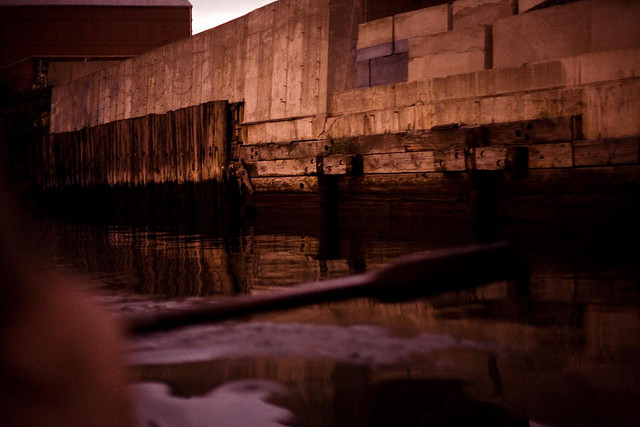Encompassed on all sides by rivers, sounds, bays and the ocean itself, gilded with an illustrious history of shipbuilding, naval dependence, house-boating and maritime commerce, how is it that the residents of New York City seem to have collectively forgotten about the waterways that surround us? So few of us ever encounter the water as anything more than something sparkling to look at, or more often, something to cross over or under, suspended safely at a height of 120 or more feet from the water’s surface, or buried deep beneath it in concrete subway tunnels.
The recent waterfront building boom that has occurred in Brooklyn has little to do with the water itself and still less to do with the waterfront. The most sought after of the new condos (always ‘luxury’ now, as if the word ‘condo’ could mean anything else when only the monied class can afford to live in one) are always 30-40 stories above the water. The ground floors are reserved for concrete embankments where the less affluent can sniff and dig and picnic at a safe remove from the shoreline itself. The new waterfront parks might fulfill a void of parks, but their location on the waterfront seems to have more to do with a certain ambiance than affinity for marine life or the changeable nature of the seas.
Maybe it is a feeling that anything positive the water possessed was buried when waterfront industry choked a hundred years ago and collapsed early in the last century, leaving its piers to rot and literally collapse even now. When we see people fishing in the East River, do we not feel a certain level of contempt or disgust for their habit, as if the water were so polluted that even so much as a good thought towards it (heavens forbid: a meal from it!) should rest like a hex on the family of the offending party, casting all those who enjoy an interaction with the water itself as some sort of soiled sub-class? Even avid sailors we know avoid the water here, afraid that it should touch their skin and somehow brand them for life.
The yachters who speed through the East River Channel must enjoy it to some extent, but their ships are the nautical equivalent of a Suburban Utility Vehicle, insulated from the experience of the road (or in this case, the water) by myriad simulacra: stabilizers, sensors, GPS navigators, infrared cameras, depth sounders, fish spotters, all while HD plasma screens screen the “Planet Earth” episode on Tidal Estuaries. Something is missing here. We do not assume to know what it is. Our project is first: a reaction to the neglect of our natural water rights, and second: an attempt to tell a story of a different sort of experience with the water, a return to it, with the understanding offered only by a close encounter. In “The Risk of Sea Level Rise,” by James G. Titus of the U.S. Environmental Protection Agency, we are told that there is a 50% chance that sea levels could rise 21 inches in New York City by the year 2100.
With less conservative predictions of sea level rises presenting far direr estimates, we propose this new experience of and engagement with the water as something that may not be optional soon, but a preparation on which we may do well to get a head start.
~ ML. Gowanus, Brooklyn, 2008.
(Included as introductory text to the first Mare Liberum broadsheet.)
